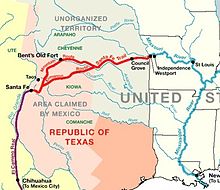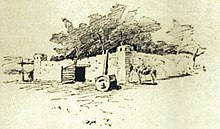Early history of the Arkansas Valley in Colorado

The early history of the Arkansas Valley in Colorado began in the 1700s and early 1800s when hunters, trappers, and traders of European descent came to the region. Prior to that, Colorado was home to prehistoric people, including Paleo-Indians, Ancestral Puebloans, and Late prehistoric Native Americans.[1][2][3]
With westward expansion of the United States, Colorado saw a number of trading posts and small settlements established in the Arkansas and South Platte valleys including Bent's Fort and El Pueblo. Southern Colorado, previously part of New Spain, was ceded in 1848 to the United States following the end of the Mexican–American War (1846-48). Significant numbers of people began to arrive during the Colorado Gold Rush of 1858. Colorado achieved statehood in 1876.[1][2][a]
Native Americans[]

A number of Native American nations traveled along the Arkansas River and lived in the area. In the early 1800s, the Arkansas River was a border between the United States and New Spain, until the land was ceded to United States following the Mexican–American War (1846–1848). The Santa Fe Trail followed alongside the river from much of Kansas into Colorado.[4]
Explorers[]
Zebulon Pike explored the Arkansas River during the Pike Expedition of 1806, during which he established Pike's Stockade. From 1820 to 1846, General John C. Frémont explored the upper Arkansas.[5]
Fur trade[]
Trappers, often called mountain men, were among the first people of European heritage to interact with Native Americans. They generally worked for a fur company,[6] like the Hudson's Bay Company that operated in the Rocky Mountains beginning in the mid-1700s.[3] The Missouri Fur Company and American Fur Company operated throughout the west in the early 1800s.[3] Pelts delivered to the fur companies were acquired through trapping and by trading with Native Americans.[7] The demand for fur robes, coats, and hats rose in Europe made for a boom in the fur trade in the early 1820s.[3] Beaver had been overtrapped in Asia and Europe, and North America, including the Arkansas River Basin of Colorado, became the supplier of beaver pelts for Europeans.[7] The Rocky Mountain Fur Company was organized in 1830.[3] In the 1840s, silk hats were in vogue and the demand for fur plummeted. In addition, beaver had been trapped out, so the supply fell as well. By 1845, most trappers had left the area or turned to other occupations, like being a guide, scout, suttler for the military. Some operated trading posts.[3][6]
Trappers played an important role in the westward expansion of the United States:
American West. They knew the easiest routes through the high mountains, which rivers could lead a party to safety and which were likely to lead to tragedy. They could tell you what you could expect to find to eat or drink and what weather or wildlife might be encountered. Much of this wealth of knowledge was passed on by word of mouth.[7]
John Gantt[]
Gantt's Picket Post, also known as Fort Gantt, was built near the present-day Las Animas in 1832 by John Gantt and Jefferson Blackwell. It operated as a trading post until some time in 1834. Fort Cass was then built near the present-day city of Pueblo, Colorado by John Gantt,[8] a former Army officer. It was built in May 1834 on the north side of the Arkansas River, about 6 miles below Fountain Creek. William Bent of St. Vrain & Company attacked Shoshone Indians trading at Gantt's Fort, killing a few and driving them away. Gantt abandoned his fort that winter. The Bents left their stockade and built Bent's Fort about 70 miles down the Arkansas. The adobe forts were built by Mexican laborers hired for construction and other work. Mexican workmen built permanent adobe forts and trading posts as far north and west as Idaho and were a major part of the frontier workforce forming the foundation of the bi-cultural population of Southern Colorado.[9][b] The trading post operated until some time in 1835.[8]
Bent, St. Vrain & Company[]


Bent, St. Vrain & Company was a partnership formed in New Mexico by Charles Bent and Ceran St. Vrain, traders on the Santa Fe Trail from St. Louis. In 1832 they entered the Indian trade as licensed traders, completing Bent's Fort in 1835 with Charles' younger brother William as manager. William Bent, as well as younger brothers George and Robert later became partners. Marcellin St. Vrain, Ceran's younger brother, who managed Fort St. Vrain for the firm on the South Platte, was never a partner. In addition to Bent's Fort on the Arkansas and Fort St. Vrain on the South Platte the firm maintained a store in Taos managed by Charles Beaubien. The firm's relations with the Cheyenne was cemented by the marriage of William with Owl Woman, daughter of White Thunder, Keeper of the Sacred Arrows of the Cheyenne. A post built on the South Canadian River to trade with the Kiowa and Comanche was only briefly maintained; however, later, two battles were fought at its ruins, by then known as Adobe Walls.[10][c]
El Pueblo[]

El Pueblo, also called Fort Pueblo, was an adobe settlement and trading post built in 1842 by a group of independent traders at the ford of the Arkansas about half a mile west of the Fountain River.[12] The exact location of the site is somewhat uncertain but is near First Street and Santa Fe Avenue in Pueblo, Colorado. The course of the Arkansas has changed by floods and the ford is gone, as is all surface evidence of the buildings at the fort. [13] The builders of Fort Pueblo included George Simpson, son of a wealthy St. Louis merchant, who at 23 had set out in May 1841 on the Oregon Trail with a mule-drawn wagon. Simpson received a yearly remittance from his father throughout his life. Simpson was side-tracked from his westward journey at Fort Laramie when he was invited by William S. Williams to join a company of fur trappers. However, he never went but was hired by Robert Fisher a trader for Bent & St. Vrain and journeyed down the Front Range of the Rockies to Bent's Fort where he learned the basics of trading with the Indians. Fisher was his principle associate in establishing Fort Pueblo.[14]
See also[]
Notes[]
- ^ Quote from source: Pueblo, Hardscrabble, and Greenhorn were among the very first white settlements in Colorado
- ^ Quote from source: John Gantt was the first to make a business of trading with the Indians on the Arkansas.
- ^ Quote from source: By 1842 Bent's Fort reigned supreme in the Arkansas Valley. Competing posts were so short lived that almost no records of them remain.
References[]
- ^ a b "Colorado". HISTORY. Retrieved 2021-10-23.
- ^ a b Lecompte 1978, pp. 1–354.
- ^ a b c d e f "BLM Cultural Resource Series: Colorado-Cultural Resources Series No. 2 (Chapter 2)". www.nps.gov. Retrieved 2021-10-24.
- ^ "History Along the Arkansas River". Legends of America. Retrieved 2021-10-24.
- ^ "Salida Colorado Arkansas River - geology and history of the Arkansas River Colorado". salida.com. Retrieved 2021-10-24.
- ^ a b "Trappers and Traders". National Park Service. Retrieved 2021-10-24.
- ^ a b c Cochran, Sue (April 15, 2019). "A look back at the area's Mountain Men". Canon City Daily Record. Retrieved 2021-10-24.
- ^ a b Lecompte 1978, p. PT9.
- ^ Lecompte 1978, pp. 10–12.
- ^ Lecompte 1978, pp. 14–17.
- ^ Lecompte 1978, p. 51.
- ^ Lecompte 1978, pp. 35–44.
- ^ Lecompte 1978, pp. 265–267.
- ^ Lecompte 1978, pp. 3–12, 35.
Sources[]
- Lecompte, Janet (1978). Pueblo, Hardscrabble, Greenhorn: The Upper Arkansas, 1832-1856. Norman, Oklahoma: University of Oklahoma Press. pp. 1–354. ISBN 0-8061-1462-2.
Further reading[]
- O.L. Baskin & Co (1881). History of the Arkansas Valley, Colorado. Chicago: O.L. Baskin & Co.
- Pre-statehood history of Colorado
- Arkansas River
- Eastern Plains